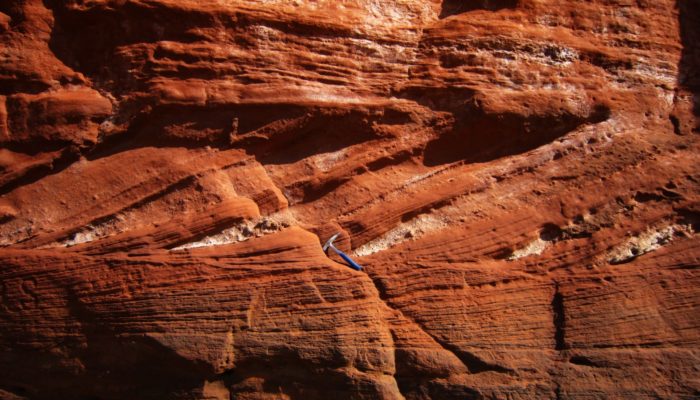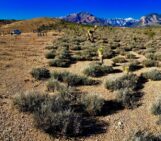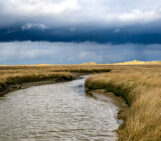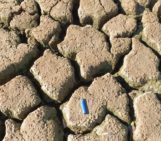
As child growing up on the south coast of Devon in the UK, I never really realised that our beaches were unusual. A glorious, glowing orange-red colour, the cliffs that you can see in this photograph by Sarah Weick produced similarly red sand beaches and warm ochre soils. The bright colour is the result of the sandstone and conglomerates of these rocks, collectively called the New Red Sandstones, being deposited during a time in the Triassic period, when this part of the world was a vast desert, approximately 251-200 million years ago.
As you can see in Sarah’s photo, taken at Orcombe in east Devon, the sandstone was laid down successively in swooping layers of cross-bedding formed through river delta deposition (where the coarser material has rolled down the foresets) and horizontal layers of floodplain deposits. Further west these sandstones are interspersed with bands of breccia and conglomerates. These coarse grained layers were the result of wadis or flash floods, which carried cobbles and pebbles from older Permian deposits and laid them down in formations like the Torbay Breccias.
It wasn’t until I was older, studying geology at University, that I learned these things about my orange cliffs; saw this ancient history they represented. For me, they will always have a deeper meaning – one of homecoming. Anyone who has travelled by train to the south west of the UK will know that the only railway line into Devon and Cornwall runs part of the way along the coast and every time I saw those sea cliffs appear, orange-red, I knew I was nearly back in my childhood town.
I moved overseas again at the beginning of the year, not knowing when I did that I would be forcibly detached from my family and friends within a few months. For many researchers this is a relatable experience, the feeling of being separated from your loved ones either by distance, economics or circumstance. To everyone who is feeling isolated right now, I hope that you have some way to connect with the people around you and that social distancing doesn’t mean that you are alone. I also hope that we will get through this outbreak safely, and that you, as well as I, will be able to be together with family and community again soon. I, for one, can’t wait to look out through that train window again, to see orange cliffs of banded sandstone and know that I’m nearly home.
Photo by Sarah Weick, description by Hazel Gibson.
Imaggeo is the EGU’s online open access geosciences image repository. All geoscientists (and others) can submit their photographs and videos to this repository and, since it is open access, these images can be used for free by scientists for their presentations or publications, by educators and the general public, and some images can even be used freely for commercial purposes. Photographers also retain full rights of use, as Imaggeo images are licensed and distributed by the EGU under a Creative Commons licence. Submit your photos at http://imaggeo.egu.eu/upload/.




